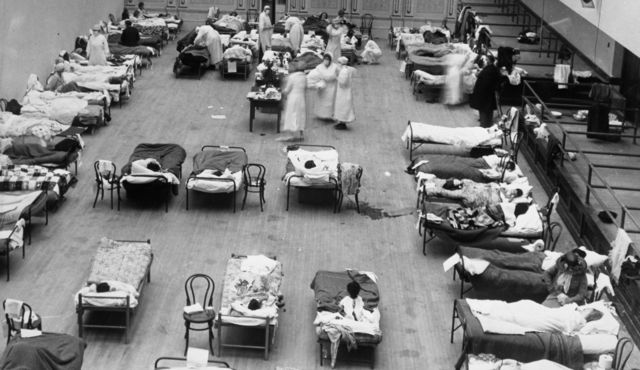Ireland has entered full panic mode in the wake of a WHO declaration that Coronavirus should be treated as a pandemic.
Supermarkets are already running out of perishable goods and there is a sense of hysteria and fear that has not been seen in generations.
But it needn't be that way.
This is not Ireland's first pandemic. It is not even Ireland's first pandemic this century.

Bread is cleared out of a supermarket amid Coronavirus panic buying - Rolling News
The Swine Flu pandemic of 2009/10 infected upwards of 1.4 billion globally, for instance, and hit Ireland harder than Coronavirus is currently hitting some of Europe's worst-affected nations.
More than 3,000 Irish people contracted Swine Flu (H1N1) and 20 people died. A total of more than 7,500 people died across Europe.
Read more: BREAKING: Irish leader announces COVID-19 shutdown to begin in Ireland
There was not nearly the same levels of panic or government warnings, and
There is one key reason for this.
Social media did not exist in the way it did today. Facebook and Twitter were both in their infancy, while Instagram and Whatsapp did not exist at all. Furthermore, newspapers were still largely confined to print editions and certainly weren't sending push notifications after every newly diagnosed case of Swine Flu.
While the death rate was significantly lower than Coronavirus, the infection rate was far higher and as many as 500,000 people died across the world during the 18-month pandemic.
A vaccine was eventually discovered for Swine Flu which resulted in a massive decrease in infection rates. Sooner or later, a vaccine will be discovered for Covid-19.
Thinking back now, it does not seem like the pandemic lasted 18 months. People went about their lives unabashed and hysteria was kept to a minimum.
In truth, that blasé attitude probably contributed to such a high infection rate.

A vaccine was discovered for Swine Flu - Rolling News
And that is why the response to this has been so encouraging.
So far, there have been 43 diagnosed cases of Covid-19 on the island of Ireland and the Irish Government, along with most other national governments, is taking dramatic and unprecedented steps to curb its spread.
In fact, governments across the world are treating Coronavirus like it is the Spanish Flu.
Spanish Flu was one of the most deadly outbreaks of influenza ever recorded in human history. It infected over 500 million people and killed between 50 million and 100 million people across the world.
Read more: A deadly “great blaze” - the Spanish flu pandemic of 1918
In a world recently torn apart by the First World War, the Spanish Flu killed everyone indiscriminately. Spanish Flu was equally deadly among the young as it was among the old and was feared the world over.
Soldiers passed it on to one another in first aid stations in France and Belgium. Critically ill soldiers were sent away from the front lines in packed railway carts and disease continued to spread.
When the war ended, returning soldiers brought Spanish Flu back to their own countries and it spread like wildfire around the globe.
Ireland was ravaged by Spanish Flu. In 1918, it accounted for 10% of deaths worldwide.
Spanish Flu arrived in Ireland in May 1918 when soldiers returned off the USS Dixie.
It arrived in a particularly lethal second wave in the fall of the same year.
In total, over 80,000 Irish people were infected and more than 23,000 people died.
But while the Irish Government is treating Covid-19 like it is the Spanish Flu, it does not mean that Covid-19 will end up being like Spanish Flu.
In reality, it won't be anything like it.
Firstly and perhaps most obviously, technology and healthcare are far more advanced today than they were over a century ago. Hospitals have access to ventilators that could mean the difference between life and death and quarantine facilities are far more secure.
Perhaps even more important is how aware everyone is of the Covid-19 outbreak. In 1918, the Spanish Flu was largely ignored by governments and media in wartorn countries.
News of the flu's outbreak was kept out of newspapers to avoid damaging the morale of the people as the war entered its fourth and final year.
That could not be any different today.
News about Covid-19 is constantly communicated by governments, media outlets and high-profile medical officials on social media. There is a slew of public health warnings about good hygiene practice and the vast majority of people seem incredibly conscious of hygiene.
Most people who returned from Coronavirus-affected regions in Italy, for instance, have voluntarily entered into self-isolation to curb the spread of the virus.
Community solidarity in the face of Covid-19 is what will ultimately limit the spread of the virus in the same way that ignorance in 1918 fostered the growth of Spanish Flu.
Spanish Flu was so ruthless because it manifested at a time when the western world was on its knees. Soldiers returning from the war were fatigued, as were the people on the home front. Additionally, supplies were low and money was short.
Soldiers were packed into crowded hospital wards which enabled the flu to spread exponentially and once it made its way into the slums and tenements in Dublin's inner city, it was almost impossible to stop.
Keeping infected patients in close quarters with healthy citizens precipitated an increased infection rate and a
That will not happen this time.
Read more: Coronavirus: What's the latest news in Ireland?
The stringent measures that the Irish Government recently imposed, including closing schools and colleges for two weeks, will greatly reduce the spread of Coronavirus.
If anyone is unfortunate enough to contract the virus, they will be immediately placed in quarantine and anyone they may have been in contact with will be tracked down. That simply wasn't possible in 1918 and it arguably wasn't happening to a satisfactory level in 2009 during the Swine Flu pandemic.
China has already proved that these stringent measures are inherently effective at containing the spread of the virus.
What was once ground zero for Covid-19 has become a beacon of hope in the fight against it.
China's aggressive policies have resulted in a drastic reduction in the number of active cases in the country.
There have been more than 80,000 confirmed cases of Coronavirus in China and, at the time of writing, there are only 14,800 active cases in the country.
Every day, there are fewer and fewer new cases and there have been just over 500 new cases since the beginning of March.
There were just 18 new cases in China on Wednesday and more than 62,000 Chinese citizens have recovered from the virus.
China's success in fighting Covid-19 has been grossly underreported by media outlets throughout the world who seem hellbent on proclaiming Covid-19 as the latest doomsday device.
However, China is proof that these stringent measures are effective and it is not outlandish to suggest that other countries cannot follow its example. South Korea has already had great success in curbing its infection rate, even if its recovery rate has not quite hit top speed yet.
With just 43 confirmed cases of Covid-19, Ireland has acted swiftly in response to Covid-19.
Yet, just because the country is on lockdown does not mean it is time to lose the head. Now is the time not to panic, but to remain calm and follow instructions.
Read more: First coronavirus death confirmed in the Republic of Ireland




Comments